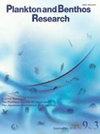A morphological note on the pelagic polystiliferous hoplonemertean Protopelagonemertes beebei (Nemertea: Pelagica)
IF 0.9
4区 生物学
Q4 MARINE & FRESHWATER BIOLOGY
引用次数: 0
Abstract
The three currently recognized species comprising the pelagic polystiliferous hoplonemertean genus Protopelagonemertes Brinkmann, 1917 are supposedly distinguishable chiefly with respect to the number of proboscis nerves: 29 (varying from 22 to 30) in P. hubrechti (Brinkmann, 1917); 19–21 (varying from 19 to 22) in P. beebei Coe, 1936; and 36 in P. joculatori Van der Spoel, 1988. A single specimen collected off the Pacific coast of Hokkaido, Japan, herein identified as P. beebei, was found to possess 19–23 primary proboscis nerves. In addition to the primary proboscis nerves, the material also possessed 12–16 secondary proboscis nerves, which are discernible from the primary nerves in that they coexist with putative glial cells. Although secondary proboscis nerves have been identified in some other species in the Pelagica, they have not previously been described for any members of the Protopelagonemertes. Our findings thus prompted us to question the validity of morphological species delimitation within this genus, given that the distinction between primary and secondary proboscis nerves has previously not been taken into consideration. Close examination of the specimen in the living state revealed that it is characterized by a pair of cephalic furrows, a structure commonly found in benthic representatives of the phylum, but herein confirmed for the first time among the Pelagica. A 658-bp partial sequence of the mitochondrial cytochrome c oxidase subunit I gene from the newly examined specimen was found to be identical to sequences derived from two other specimens previously collected in Sagami Bay, thereby indicating that P. beebei may occur commonly in Japanese mesoto bathypelagic waters.远洋多生单栖水生动物Protopelagonemertes beebei的形态学研究(新目:远洋目)
目前公认的三个物种组成了远洋多tilitis hoplonemertean属Protopelagonemertes Brinkmann,1917,主要根据长鼻神经的数量可以区分:P.hubrechti中的29个(从22到30不等)(Brinkman,1917);19–21(从19到22不等),毕贝科,1936年;P.joculatori Van der Spoel,1988年,第36页。在日本北海道太平洋海岸采集的一个标本,本文鉴定为毕贝P.beebei,被发现拥有19-23条初级长鼻神经。除了初级长鼻神经外,该材料还具有12-16个次级长鼻神经,这些神经与初级神经不同,因为它们与假定的神经胶质细胞共存。尽管在Pelagica的其他一些物种中已经发现了次级长鼻神经,但以前还没有对原Pelagonemertes的任何成员进行过描述。因此,我们的发现促使我们质疑该属形态物种划界的有效性,因为以前没有考虑初级和次级长鼻神经之间的区别。对活体标本的仔细检查表明,它的特征是有一对头沟,这种结构通常在该门的底栖生物代表中发现,但在Pelagica中首次得到证实。来自新检测标本的线粒体细胞色素c氧化酶亚基I基因的658 bp部分序列被发现与之前在相模湾采集的另外两个标本的序列相同,从而表明山毛榉可能常见于日本中深海水域。
本文章由计算机程序翻译,如有差异,请以英文原文为准。
求助全文
约1分钟内获得全文
求助全文
来源期刊

Plankton & Benthos Research
Agricultural and Biological Sciences-Aquatic Science
CiteScore
1.30
自引率
0.00%
发文量
32
期刊介绍:
Plankton and Benthos Research is a peer-reviewed journal publishing quarterly original papers, reviews and notes dealing with any aspect of the biology and ecology of planktonic and benthic organisms and their interactions with the environment in any aquatic system, and is open to all scientists around the world. Submission of a paper is held to imply that it represents an original contribution not previously published and that it is not being considered elsewhere.
 求助内容:
求助内容: 应助结果提醒方式:
应助结果提醒方式:


